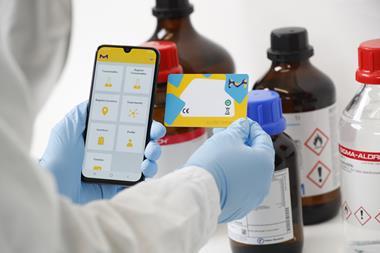Accelerating innovation in business is often about encouraging organisations to take a new approach. This live stream seminar shows how
Most organisations are keen to establish an innovation culture, and many claim to have one already. Yet fostering a true innovation culture is often at odds with the pressures these same organisations face to deliver results with limited resources, constraints on time and tight control of costs. These factors can hamper new ways of thinking and encourage teams to stick to old working methods. What can R&D professionals do to achieve their next breakthrough when there is always more work than time available and outcomes are often unpredictable? It can come down to having the right mindset for experimentation in the first place.
Developing an exploratory mindset

Johnson Matthey’s principal scientist Pilar Gomez-Jimenez has a master’s degree and a PhD in chemical engineering. She has been working in catalysts and materials R&D for 15 years. Gomez-Jimenez has seen that starting with the right mindset towards experimentation can make a big difference to efficiency and working practices.
In the Chemistry World webinar Using a DoE mindset for successful experimentation, Gomez-Jimenez said ‘as humans, we struggle to visualise a multivariate experimental space’. ‘We are able to imagine the effect of changing temperature, but if we are moving temperature and pressure at the same time, then analysing the data gets more complicated and our minds struggle to visualise it,’ she explained.
As a result many experts working in R&D today retain a traditional experimentation mindset, moving one variable at a time – simply because that’s how they were taught. The team may think it is focused on achieving optimum settings from the outset but such an approach can end up constraining innovation and decreasing efficiency in the long run.
A more exploratory mindset will consider the whole experimental space to try to find the optimum outcome. It is important to allow time to create a plan up front. There are usually many factors that might have an effect and it is crucial that all possible factor combinations are explored efficiently, not one at a time, and to predictably understand the optimum approach required. By actively manipulating factors according to a pre-specified plan, it is possible to gain a useful, new understanding of relationships between inputs and outputs and achieve faster, more predictable cycles and save time. In short, it is vital to know when a concept will work and when it will not.
Delivering value through informed experimentation
Gomez-Jimenez is a keen proponent of establishing a systematic method to determine the relationship between factors affecting a process and the output of that process. She takes a strategic, data-driven approach that helps scientists and engineers work more productively and extract more valuable insights from their experiments – while also reducing product development costs. ‘[Because] you’re looking at the full experimental space and getting a proper map of what the results will be and the interactions between the variables, the result is greater insight and confidence in the conclusions,’ adds Gomez-Jimenez. This approach helps scientists design and analyse results rapidly and in a visual way, enabling them to understand the analysis quickly and explain it to other people. Visualisation is key to demonstrating the value of the process to the wider organisation without needing an in-depth knowledge of statistical analysis.
Making a start

It is important to make the leap without fear of failure. Julia O’Neill has over 30 years’ experience using statistics and chemical engineering to solve problems in chemistry, vaccines, biologics and pharmaceuticals. O’Neill has seen how introducing statistically designed experiments can help change an organisation’s approach: ‘One of the things that holds people back is they feel like they have to get it perfect before they can start,’ O’Neill said in the JMP webinar Bridging statistics and chemical engineering for biotech and pharma. ‘Dive in and try it. You can start fairly small and simple. Because you have to put in the up-front planning, people perceive it as being more work and more effort but in the end, it saves so much time.’
Gomez-Jimenez sees no disadvantages to taking a data-driven approach to planning experiments. There are plenty of advantages over and above saving time and resources. Improved predictability helps with planning and enables more efficient ways of working. This efficiency can help to ease the stress levels within teams under pressure to deliver. Common fears about adopting this approach may include the additional planning time required, or a need for in-depth knowledge of statistical analysis. With the right tools to support the approach, it is easy to get started and experience some quick wins.
These results can help to convince colleagues, teams and the wider organisations that there are significant benefits to be achieved if they embrace new techniques. With the right tools available to manage the process, organisations can make better decisions faster and meet project milestones more predictably. Reducing the stress levels on individuals by giving them the right tools to be productive and efficient can benefit the whole organisation.
Those who embrace the approach report shorter and more predictable projects, driven by a clear plan. They gain more insights into the problems they are trying to solve. They also have more confidence in their conclusions because they know they are looking at the full experimental space encompassing all the interactions between the different variables. Whether supporting the delivery of better solutions, products, or services, a statistically designed approach to experiments can accelerate the discovery and creation of viable new solutions that can be delivered at scale.
Embracing the exploratory mindset and enabling the success of the subject matter expert can be a vital step in establishing a true innovation culture. Join us for a discussion about the power of using smart trial and error processes to speed up innovation, achieve faster more predictable cycles and save time.

Register for the upcoming live stream seminar Smart trial and error for rapid innovation to learn how to put cutting-edge trial and error to work at your organisation.
The seminar’s keynote will be from JMP’s principal research fellow Bradley Jones.
19 March 2020 1000 – 1200
Babraham Research Campus
Cambridge, UK or online


















No comments yet